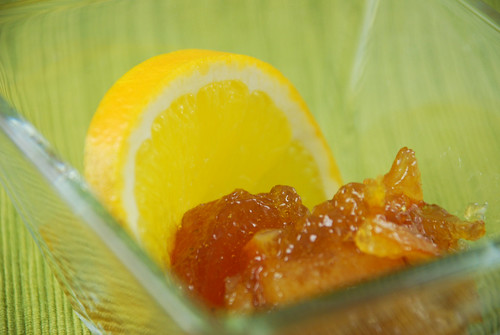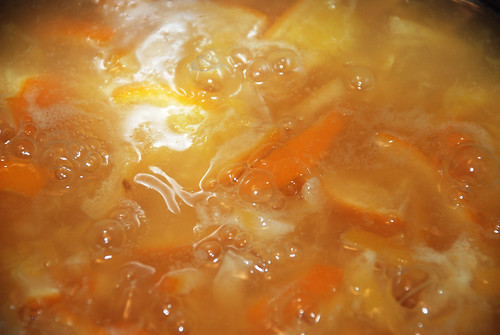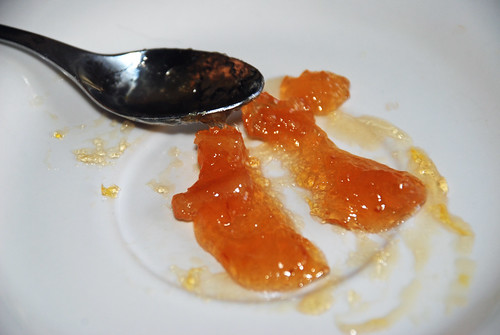The first thing that struck me was the abundance of fruits and vegetables. I hadn’t stepped into a North American supermarket in over a decade, and had expected it to feel familiar and comfortable, but somehow it didn’t. There was something here that made me feel uneasy – which is an odd thing for fruits and vegetables to do. Against the backdrop of the bizarre food experiences I’d had living and traveling in Asia, how could a stack of onions not feel normal? From a food perspective, Asia had been such a strange ride, right from the beginning…
* * *
It was August, 1998 – the evening of the 22nd, to be exact — and Bonnie Lee and I were heading out for a special meal. The town had no street names, and we had only a Japanese map to guide us. If we were concerned about anything at all, it was that we’d be late for our reservation, or not find the restaurant at all. We had no idea what to expect when we got there; no idea that we’d soon be greeting our long-anticipated celebratory meal with horror; no idea that this was one of the countless Asian experiences that would change our relationship with food forever.
There was a lot we didn’t know.
We were fresh off the boat. We’d been living in Kitakyushu for just over a month, and it wasn’t at all what we’d expected. The apartment we lived in was old and run down, and it had a squat toilet. The bugs in Southern Japan were like something out of a science fiction movie, and the fauna in our apartment included dani (little red biting critters that live in tatami mats) and mukade (venomous, armored centipedes). The river that ran through Kitakyushu was brown, and its basin was lined in concrete – the only legal construction material in the area, it seemed. The exotic rural charm we’d been expecting wasn’t really what Kitakyushu was known for; it was more famous as center for toilet manufacturing.
Oh, and it was hot.
The temperature had been hovering around 90℉ since our arrival; the humidity, around 85% – which was a challenge given the lack of air conditioning at home and at work. We weren’t at all sure we’d made the right move in coming to Japan for a year, and as the guy who’d suggested the move, I had a lot riding on this dinner.
We’d just gotten our first paychecks, and this was our first indulgence. Food was one of the things that had drawn us to Japan, and the restaurant had been recommended by a coworker. His English was bad, and my Japanese was worse – so I hoped that I had managed to communicate just how special I needed this night to be. I wanted something purely Japanese, something extravagant that we could never find elsewhere, something with air conditioning.

We found the place easily (though we had to double and triple check the Chinese characters on the door to make sure), and it seemed perfect. The building was made of dark wood, not concrete, and the dining area was small, quaint and well appointed. There were white table cloths, and the waitstaff was attentive a very professional. The menus were in Japanese, of course, and none of the waitstaff spoke English, but that was no surprise. We were very likely the first non-Japanese who had ever entered the place – perhaps the only ones who ever would. And although we couldn’t read, we knew a few phrases, the most important of which was, Osusume wa …? – “What do you recommend?” We didn’t quite understand the whole answer, but it contained a few words we did know: sake, oki and ebi – rice wine, big and shrimp. Perfect. Local wine and jumbo shrimp. We ordered that.
The sake came along with a few small, beautiful starter dishes, and it was lovely. It was served cold, and complex – nothing like the pure, harsh ethanol they call sake in North America. We were excited to see what would follow. It wasn’t long, however, before that excitement turned into something quite different.
The oki ebi – which was actually lobster and not jumbo shrimp – came out in a small basket. On some level, it was beautiful. It was served on a bed of shredded daikon, and decorated with wasabi, a couple of slices of carrot, and a few fresh, bright green shiso leaves. But all that freshness and beauty were juxtaposed with something else altogether. The lobster meat, which was uncooked, was garnished with the head and thorax of the mutilated but still-living lobster, which sat upright in the daikon in obvious distress.
Now, many people would argue that a lobster’s capacity for pain is minimal, if not nonexistent – but here’s what I know for certain: whatever that capacity is, this lobster was feeling the extent of it. It was having as bad a day as any lobster can have. Its eyes were wiggling back and forth frantically at the end of their little lobster eye stalks. Its antennae, which were long and fell outside the basket, were in constant motion. If its legs were still attached, it would have been trying to get away – but those legs were impotent now, and arranged neatly in front of it on a bed of daikon.
We were a little taken aback.
Although neither of us was (or ever became) a fan of raw shellfish, we felt that we had to eat our new tablemate. To not eat it at this point seemed like far too great a waste – though there was no way we wanted to eat it while it was still staring at us. Our initial plan was to wait until it stopped moving, but after 15 minutes it became clear that the creature was determined to live despite its obvious challenges. We placed it face down in a (clean) ashtray, and ate its flesh while it died.
* * *
Despite the disturbing meal, despite the concrete, despite the bugs, despite everything, we ended up enjoying Japan that year, and for the next twelve years after that. In that time, we traveled both in Japan and in the rest of Asia, and our notions of food were constantly challenged. Some images that stand out: buckets of silk worm pupae sold as snacks in Seoul, bright purple meat topped with the disembodied dog heads in a street market in Hanoi, fried grasshoppers in Bangkok, perfectly bronzed Peking duck served with bill and all … well, you get the picture.


So what was it about this supermarket in L.A. that I could possibly find so disconcerting? Well, for one thing, the celery. In Japan, celery is sold by the stalk, and each stalk costs about a dollar. Over the years, that had come to seem normal. When you spend a dollar or more on a stalk of celery, you don’t do it casually. You buy it because you have a use in mind. You don’t just slather it in Cheese Whiz and wolf it down. You prepare something that highlights its crunch and flavor. You savor it, perhaps over two meals … or even three.
On some level, I’d been looking forward to buying bunches of celery again, but now that I could, it seemed wrong. The bunches were huge – much bigger than I remembered – and I couldn’t even begin to imagine how I would use a whole bunch in a week. Images from childhood popped into my head – images of wilted, unused celery stalks finding their way into garbage cans by the dozen. After thinking in terms of individual stalks for so long, that was a level of waste I couldn’t comfortably be complicit in.
Not far from the celery, I saw something that surprised me: yamaimo, mountain yams indigenous to Japan – and a food which I have a personal connection to. My first year in Japan, Bonnie Lee and I had headed into the mountains in search of yamaimo with a friend. We had dug waist-deep holes for hours in hard dirt, and had emerged from the day exhausted, with one, tiny, misshapen yamaimo to show for our trouble – and our friend was thrilled with the haul. He turned that one six-inch root into three dishes that celebrated the elusive tuber’s raw earthiness and glutinous texture. He turned one little yam into a feast for three, and a precious memory.
Understanding the amount of effort that went into finding one yam, the whole notion of wasting even a gram of it was out of the question. But what did an exotic yam with a slimy texture represent to the typical shopper here? Perhaps just an experiment that could easily be discarded if it didn’t work out. On some level, that was at the core of what I was feeling in the market that day. It was as if all the food had been stripped of any intrinsic value. It was cheap, plentiful and robbed of all history, of all connection to labour and life.
In China’s Guangxi province, there is a village called Ping’an, which sits in the heart of some of the most impressive terraced rice fields in the world. The town houses about 180 families, and their ancestors carved the terraces out of the surrounding mountains over a period of about 300 years. The slopes are steep, and the only way to get there is by foot. It’s well worth the walk. From Ping’an, the terraces spread out as far as the eye can see. When the rice fields are flooded, the landscape is made of giant mirrors — and during the growing season, the mountains are ringed with bright green contour lines.

In Ping’an, people get the value of arable land – they had to build theirs from scratch – and they get the value of the food that grows on it. We were fortunate enough to have a meal there, which was a tribute to the valley that spread out in front of us. Our lunch for two consisted of six bite-sized pieces of chicken fried in a glutinous rice paste, a light soup made from the wild mountain vegetables that grow between the terraces, and a small bowl of rice – and it was served with an 8 ounce glass of sweet, smooth, weak rice wine.
Everything was from the land, and the portion size was enough to thoroughly satisfy, but not enough to stuff – designed to virtually eliminate the possibility that guests would leave something uneaten. Nothing was wasted. When you waste food in Ping’an, you see what you are wasting: the effort that went into building the very land, and the effort of those you can see working in the fields.

Not so in our local supermarket. Here, it seems that the relationship we have with food is broken. Half the aisles are filled with chemical experiments that our ancestors would barely recognize as food. We’ve transformed produce and meat into an industrial products, and commoditized them, removing all our connection to them. At least dog heads on piles of meat are honest. They remind you where the meat came from. They remind you what was given up so you could eat. They remind you not to waste. And, although I didn’t enjoy watching that one lobster suffer, that memory serves as a constant reminder of where I chose to stand in the food chain, and of the connection I have to the living things that are affected by my choices.













 There was a lot of coverage on food waste again this week, mostly inspired by the UN’s
There was a lot of coverage on food waste again this week, mostly inspired by the UN’s 



 Reblogged from Food Cowboy:
Reblogged from Food Cowboy:




 You may have noticed that I don’t post a weekend roundup every week. When I don’t post, it’s usually because I haven’t found enough articles or videos that have something new to say about food-waste-related issues. Most of this week’s articles are ones that I wouldn’t usually post, but what I found interesting this week was the sheer number of articles that have been published on the topic. In my
You may have noticed that I don’t post a weekend roundup every week. When I don’t post, it’s usually because I haven’t found enough articles or videos that have something new to say about food-waste-related issues. Most of this week’s articles are ones that I wouldn’t usually post, but what I found interesting this week was the sheer number of articles that have been published on the topic. In my